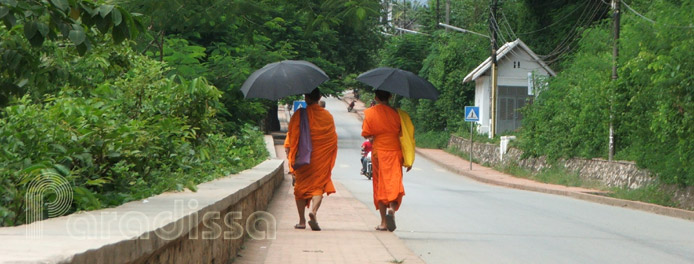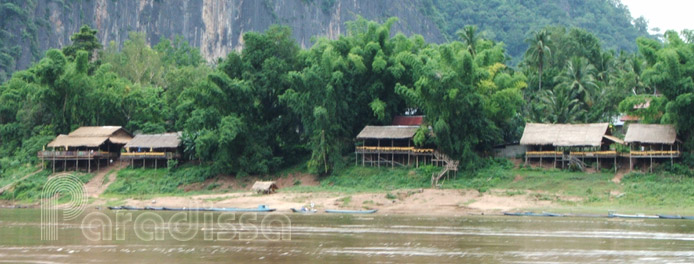Theravada Buddhism is followed by 60% of Lao population and it's the most popular religion in the country. King Fa Ngum, the first king of Lan Xang Kingdom, declared Theravada Buddhism the state religion in the 13th century. Others following kings were active patrons of Buddhism building more wats, teaching the religion in schools...
Theravada Buddhism is considered more original than Mahayana Buddhism since it is based on the Buddha's earliest teachings. Theravada Buddhism is to preserve and to limit the Buddhist doctrines to those teachings of the Buddha only. While Mahayana is not only based on the earliest canons, but also expand them to make it more suitable to different cultures and to more varieties of lay people's needs. Theravada Buddhism took the southern route and developed in India, Sri Lanka, Myanmar, Thailand, Laos, Cambodia; Mahayana took the northern route and developed in Nepal, Tibet, Mongolia, Korea, Japan, China, Vietnam. That's why Theravada is also called the Southern School of Buddhism and Mahayana is called the Northern School of Buddhism.
Theravada Buddhism is based on 3 concepts founded by Shiddartha Gautama, an Indian Prince, in the 6th century B.C:
- dukkha, or suffering exists – one being born, lives and commits disease and dies; loves and separated; has unsatisfied needs;
- anicca: everything is transient and whimpsy, things keeps changing constantly;
- anatta: non-essentiality, nothing has something unchanged or can be pointed to and say this is it or that;
The Four Noble Truths of Buddhism:
- Suffering is the truth in all forms of existence;
- The cause of suffering is ignorance and grasping;
- To be salved from suffering, ignorance and grasping must be eliminated;
- The means to eliminate suffering is the Noble Eight-Fold Path: right understanding, right mindedness; right speech; right sexual conduct; right livelihood (vocation); right effort; right thinking and right meditation. The practice of the Noble Eight-Fold Path must be in balance which means to avoid extreme austerity and extreme sensuality. Once all the causes of sufferings are eliminated, nirvana is the state of mind is reached and this is meant to be the goal of Theravada Buddhism.
In Buddhism, karma means the retribution of actions: what one does in the past and present leads to one's future fate. The process of killing and eliminating sufferings is through acquiring enough merits. The best way to acquire enough merit is through entering shangha which means entering the Buddhist monk brotherhood.
Among Lao Buddhists, every male is expected to become a monk for a certain period of time ranging from a week to 3 months. Some may be in shangha all his life. The females may enter shangha but can not be monks who conduct Buddhist ceremonies.
Entering shangha acquires merits for the person and his parents. Lao Buddhist family is very proud if their son enters shangha. As a Buddhist novice, one has to commit 10 vows which includes against killing, lying, stealing, taking intoxication and sexual involvement. A monk must follow 227 vows. Monks must detach from the normal world and can not have possessions. Monks can not work to earn a living either. All food for the monks is to be donated by the Buddhist followers. The food givers also acquire more merits donating food to monks. Buddhist followers in Laos don't normally acquire merits for more possibility of entering nirvana, but only to improve their life and reduce the number of rebirths.
Apart from Buddhism, animism is also popular in the majority of the Lao population. In fact, prior to Buddhism, animism was the most popular. The Lao tends to believe in the existence of spirits of their ancestors, of places or of things. Nowadays, animism is more popular among the Lao Theung and Lao Sung than the Lao Loum.
Also there is some in the population following Christianity, Protestant, Muslim or Catholicism.
It's very likely that when traveling in Laos, you'll tour many Buddhist temples and wats throughout the country, it's always worth to learn more about the practice of the Lao Buddhist at each locality as wats are normally the focal point of the life at each village or community. If your trip happens to be in new moon, full moon or during religious festivals in Laos, then there are more opportunities to experience the religious life of the people.












